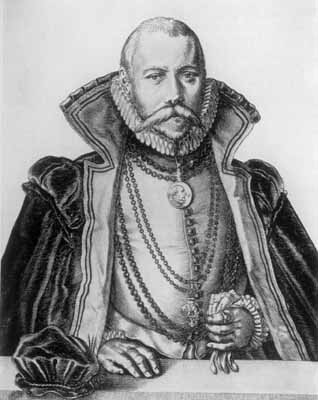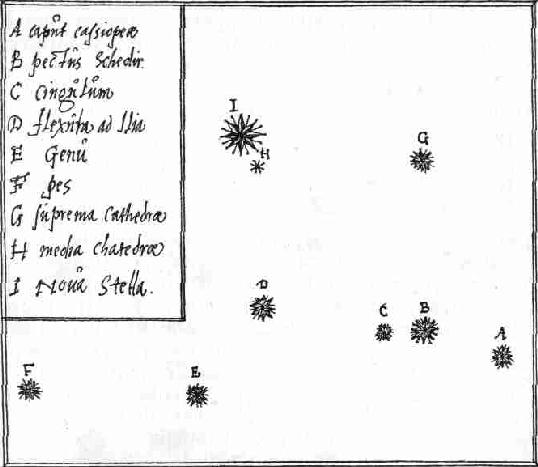 A Danish nobleman, Tycho Brahe (1546-1601), made
important contributions by devising the most precise
instruments available before the invention of the telescope
for observing the heavens.
A Danish nobleman, Tycho Brahe (1546-1601), made
important contributions by devising the most precise
instruments available before the invention of the telescope
for observing the heavens.
 On 11th November 1572 Tycho observed a new star
in Cassiopeia. He showed that it
really was a distant star and not a local phenomena. This was very
intriguing at that time, since the sphere of the stars was
divine and perfect no changes ought to take
place there. He reported the event in his book "De stella
nova", which made him famous all over Europe. To this day,
the stellar remnant is still referred to as `Tycho's Supernova'.
On 11th November 1572 Tycho observed a new star
in Cassiopeia. He showed that it
really was a distant star and not a local phenomena. This was very
intriguing at that time, since the sphere of the stars was
divine and perfect no changes ought to take
place there. He reported the event in his book "De stella
nova", which made him famous all over Europe. To this day,
the stellar remnant is still referred to as `Tycho's Supernova'.
Soon after, Tycho was lavishly supported by the King of Denmark to continue his astronomical research. Tycho made his observations from Uraniborg, on an island in the sound between Denmark and Sweden called Ven. This is estimated to have cost Denmark more than 5% of its Gross National Product, an all-time world record.
Tycho designed large instruments such as sextants, quadrants and armillary spheres, and a very accurate aiming device and found a way to divide the angular scales to an accuracy of half an arcminute, i.e. 1/120 degree. Tycho's observations were a hundredfold more accurate than the previous ones.
Tycho compiled extensive data on the planet Mars, which would be sufficiently precise to demonstrate that the orbit of Mars was not a circle but an ellipse (by J. Kepler).
Tycho's Universe
Tycho believed in a geo-centric universe. However, he did allow
all the other planets to revolve around the Sun, thus it had more
in common with the Copernican model than the Ptolemaic model.
Tycho's generous scientific support ended when Danish King Frederik II died in 1588. He found support in the Bohemian capital of Prague, and moved shortly thereafter. He died rather suddenly of a urinary tract infection (he may have been trying to cure himself by drinking mercury!). Luckily, he had just hired Johannes Kepler as an apprentice.